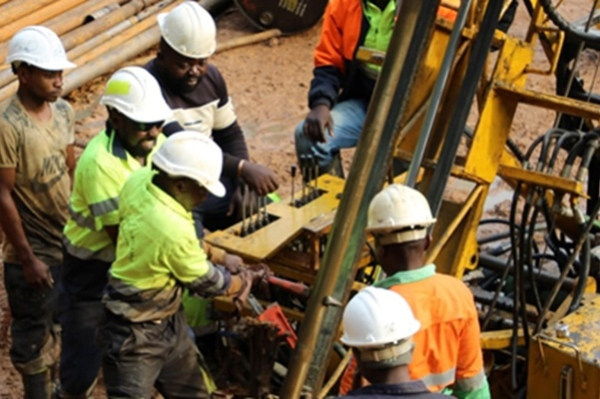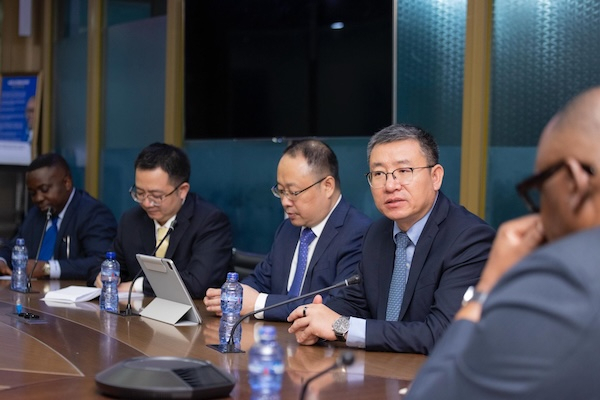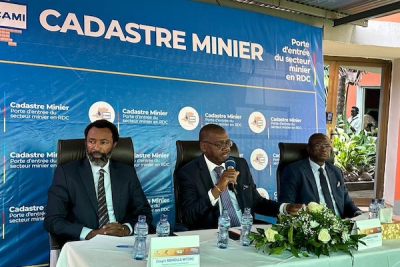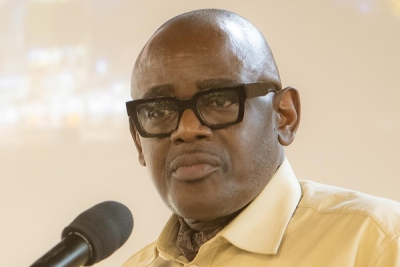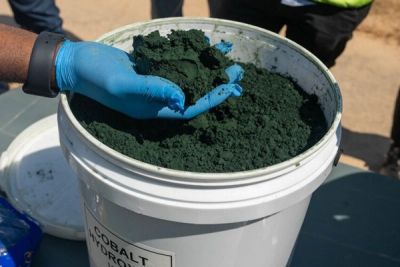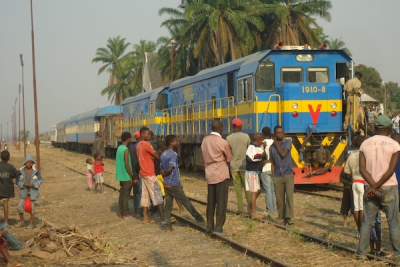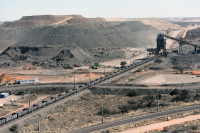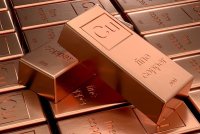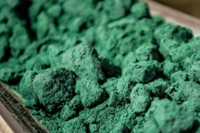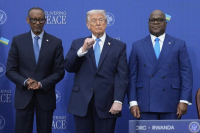
MINING (161)
-
Company is assessing the economic viability of copper at Bisie North
-
Ongoing metallurgical tests target copper zones above tin mineralization
-
Tin remains the main exploration focus at the project
UK-based Rome Resources is assessing the economic potential of copper mining at its Bisie North project in the Democratic Republic of Congo. In an update published on December 23, 2025, the company said it is on track to finalize studies under way, at a site where tin remains, at this stage, the primary exploration target.
Over the course of the year, Rome Resources commissioned metallurgical work to assess processing methods that could allow for the economic recovery of significant copper resources located above the tin zones at Mount Agoma. The first phase of this work is nearing completion, with results expected soon, according to the company.
Published in late October 2025, Rome Resources’ maiden resource estimate highlighted the polymetallic nature of Bisie North. The estimate identified 10,600 tons of tin and 46,900 tons of copper. It is this copper potential that the company is now seeking to better develop through the metallurgical work currently in progress.
The studies involve a series of tests designed to assess the conditions under which copper extraction could be economically viable. This includes identifying the most suitable processing method and evaluating the quality of the final product.
By focusing on the copper resources at Bisie North, Rome Resources is also positioning itself in a strategic market. Copper is essential to key sectors such as electronics, renewable energy, and electric mobility and is now widely regarded as a critical metal. In this context, the International Energy Agency has warned of a potential supply shortfall by 2035, driven by demand expected to rise sharply.
Rome Resources’ ability to capitalize on these opportunities will depend on the outcome of the ongoing work, with no indication at this stage of its likelihood of success. In the meantime, the company plans to continue exploration activities, including the launch of a new drilling campaign in the first quarter of 2026.
Aurel Sèdjro Houenou, Ecofin Agency
Chinese mining group CMOC plans to raise its total investment in the Democratic Republic of Congo to $8 billion, the Ministry of Mines said.
The plan was announced on Dec. 16, 2025, during a meeting in Kinshasa between CMOC representatives and Mines Minister Louis Kabamba Watum, according to a statement from the ministry. CMOC operates the Tenke Fungurume Mining (TFM) and Kisanfu Mining (KFM) projects in the country.
Details on the scope and timeline of the planned investments were not disclosed. CMOC said it intends to deepen its engagement in the DRC, citing the country’s mining potential and an improving business climate.
In October 2025, the group’s board approved a $1.08 billion expansion of the Kisanfu mine, aimed at increasing annual copper output by about 100,000 tonnes. Construction is expected to take two years, with commissioning targeted for late 2027.
CMOC acquired an 80% stake in Tenke Fungurume Mining for $2.65 billion in 2016 and a 95% stake in Kisanfu Mining for about $550 million in 2020. The group has since made additional investments to expand production capacity at both sites, bringing total spending to more than $3 billion, based on its annual reports.
During the meeting, CMOC also presented its annual production figures, reporting roughly 700,000 tonnes of copper from its Congolese operations in the 2025 financial year, making it one of the country’s leading copper producers.
The company flagged several operational challenges, including power supply shortages and encroachment by artisanal miners on some concessions, which have disrupted operations and fuelled local tensions.
Watum said coordinated solutions would be pursued with all stakeholders and stressed the need to involve local communities in addressing concession encroachments. He also urged CMOC to invest in local power generation to reduce reliance on electricity imports from neighbouring countries.
The talks also touched on recent cooperation agreements between the DRC and other international partners, including the United States. The minister said these partnerships do not pose a threat to foreign investors, including Chinese companies, or to existing Sino-Congolese cooperation.
Ronsard Luabeya
The Mining Registry (CAMI) of the Democratic Republic of Congo has suspended new applications for mining and quarry exploration rights, effective Dec. 17, 2025. The decision was announced in a statement issued on Dec. 15, 2025. The suspension will remain in effect until further notice, as no reopening date has been set.
CAMI said the measure does not affect operations under existing rights. Applications to convert or renew mining rights, as well as registrations of assignments, leases, options, and other related transactions, will continue to be processed.
According to the registry, the decision forms part of an effort to clean up the mining cadastre. The aim is to improve the accuracy and management of the cadastral system.
The work builds on measures launched last July. A report published in August 2025 said those measures enabled the Congolese state to recover 594 mining and quarry titles. These titles covered 37,253 mining squares, representing a total area of 31,648 square kilometers, larger than Belgium.
The report also cited the administrative regularization of 210 mining rights that had been under prolonged force majeure, covering 18,709 mining squares. These titles were reclassified as active, restoring the fiscal, social, and technical obligations of the companies concerned.
Ronsard Luabeya
The government of the Democratic Republic of Congo has reminded mining companies operating in the southeastern provinces of Haut-Katanga and Lualaba of their obligation to comply with new rules governing fuel use in the sector.
In a letter dated December 10, 2025, and signed by the Ministers of Hydrocarbons, Acacia Bandubola Mbongo, and Mines, Louis Watum Kabamba, the authorities said the reminder followed repeated refusals by several mining operators to grant access to their sites to inspectors from the Petroleum Product Marking Brigade.
According to the letter, the inspectors were seeking to verify fuel stocks in order to ensure that state-subsidized petroleum products intended for household consumption were not being diverted for industrial use at mining sites.
Under Article 22 of the 2025 Finance Law, fuels intended for land and aviation use in mining activities, including gasoline, kerosene, diesel, fuel oil, lamp oil and liquefied petroleum gas, or supplied to mining companies and their subcontractors, are excluded from all public subsidies. They are also no longer eligible for exemptions from import duties and taxes, notably customs duties and value-added tax.
To ensure enforcement of the measure, mining companies are now required to source their fuel supplies under customs supervision and to use products subject to specific molecular marking. This marking allows subsidized fuels sold at service stations to be clearly distinguished from fuels imported for industrial use.
Since the measure took effect in August, the Directorate General of Customs and Excise has suspected certain mining operators of attempting to circumvent the system. As a result, unannounced inspections were launched by the Petroleum Product Marking Brigade. However, between September 7 and 12, several inspection teams were denied access to fuel storage facilities at some mining sites in Lualaba province.
These incidents prompted the ministers to formally remind mining companies of their obligations and to call for full cooperation with inspection authorities.
In the letter, the ministers said that inspections by the Molecular Marking Brigade will now be conducted jointly with administrative checks by the hydrocarbons authorities. These inspections will focus in particular on installed fuel storage capacity, monthly fuel import and consumption volumes, the availability of customs declarations, and the validity of authorizations covering fuel importation, transport and storage for self-consumption.
According to Deputy Prime Minister in charge of the National Economy Daniel Mukoko Samba, the reform has already had a significant impact on public revenue. Fuel imports generated more than 63 billion Congolese francs, or about $22 million, in August 2025, compared with just 4 billion francs, or roughly $1.5 million, the previous month, representing a more than fifteen-fold increase.
Boaz Kabeya
With around two weeks remaining in 2025, the Democratic Republic of Congo is still piloting a new cobalt export procedure under its quota system. Many mining companies now say they will be unable to use their full annual allocations and are questioning what will happen to any unused quotas.
Under an Oct. 10, 2025 decision by the board of the Regulatory and Control Authority for Strategic Mineral Substances Markets (ARECOMS), which set the conditions for obtaining, allocating, and executing cobalt export quotas, base quotas per operator are neither transferable nor carried over into a future period. The decision states that any monthly export quota not used by the last day of the month in question is considered lost and automatically reallocated to ARECOMS’ annual strategic quota.
The decision includes an exception for this year. Monthly quotas per operator are exceptionally cumulative until Dec. 31, 2025, but no carryover from one year to the next is permitted. If applied strictly, companies unable to export their full 2025 quotas would forfeit them. Industry representatives say this would be unfair, arguing that the delays are not the operators’ fault.
Asked to comment, ARECOMS told Bloomberg that quotas from the last quarter would not be lost by mining companies and that it was examining all implementation options to limit the impact. The U.S. media also said DRC authorities had allowed producers to retain their 2025 quotas. However, as of the end of last week, several industry players said they had received no official notification to that effect.
Cobalt exports were due to resume on Oct. 16 but remained blocked for more than a month due to the lack of formal implementing rules required under ARECOMS directives. The interministerial Mines and Finance circular setting out the practical arrangements for cobalt exports was published only on Dec. 2. According to the Mining Chamber of the Federation of Enterprises of Congo (FEC), the document does not address concerns raised by cobalt exporters.
Authorities have since launched a testing phase, which began last week with a small shipment of cobalt belonging to Glencore, the owner of Kamoto Copper Company (KCC) and Mutanda Mining (MUMI) in Greater Katanga. “All means are being deployed to finalize the testing phase in the coming days, which will mark the resumption of cobalt exports from the DRC,” ARECOMS told Bloomberg.
Operators hope that once this phase is completed, the regulator will agree to talks to clarify ambiguities in the new system. According to industry sources, as of the end of last week, Mines Minister Louis Watum Kabamba had not responded to correspondence sent by the Mining Chamber on Dec. 4 requesting a working session under the consultation mechanism established in October.
For the fourth quarter of 2025, ARECOMS authorized the export of 18,125 tonnes of cobalt. CMOC and Glencore hold 58% of these volumes, with allocations of 6,500 tonnes and 3,925 tonnes respectively. Annual production is expected to reach nearly 200,000 tonnes.
Pierre Mukoko & Ronsard Luabeya
The U.S. International Development Finance Corporation (DFC) said in a statement dated December 5, 2025, that it had issued a Letter of Intent to Mota-Engil, signaling its readiness to help finance the rehabilitation and operation of the Dilolo-Sakania railway line in the Democratic Republic of Congo (DRC).
The move suggests that the Portuguese construction group is emerging as the frontrunner to secure the concession for the Congolese section of the Lobito Corridor, which links the DRC’s mining regions to the Atlantic port of Lobito in Angola.
Mota-Engil, together with Trafigura and Vecturis, forms the Lobito Atlantic Railway (LAR) consortium. The consortium has held a 30-year concession since July 2022 to operate and modernize the Angolan stretch of the corridor. The DRC, however, has not yet publicly announced who will be awarded the concession on its territory.
“What we are trying to do now is get the work started,” said Deputy Prime Minister for Transport Jean-Pierre Bemba on November 26 during a panel at the Makutano Forum. He said discussions are advancing within the strategic steering committee that brings together the DRC, the United States and the European Union.
With backing from the United States, Mota-Engil appears well-positioned in the process. The DFC has said it is prepared to mobilize up to 1 billion dollars for the project. The Dilolo-Sakania rail line is expected to become the main route for Congolese exports to the United States. Under a strategic agreement signed on December 4 between Kinshasa and Washington, public enterprises are expected over the next five years to send 50 percent of their copper, 30 percent of their cobalt and 90 percent of their zinc through the Lobito Corridor.
Economic Stakes
Feasibility studies presented in September by a joint European Union-U.S. expert mission estimate the cost of rehabilitating the Dilolo-Sakania line and extending it toward the Zambian border at about 1.1 billion dollars.
Current financing commitments already surpass that amount. In addition to the 1 billion dollars being considered by the DFC, the European Investment Bank is ready to contribute 500 million euros, and the World Bank is prepared to provide 500 million dollars, according to Bemba.
If implemented, the corridor is expected to give the Port of Lobito a competitive advantage over major regional ports such as Durban (South Africa), Dar es Salaam (Tanzania), Beira (Mozambique) and Walvis Bay (Namibia). Transporting freight from Tenke or Kolwezi to Lobito would take between five and eight days, compared with nearly 25 days for Durban. According to the transport minister, this reduction in transit time could lower logistics costs by up to 30 percent. In the first year of operations, authorities expect export volumes of 1 million tons and import volumes of 500,000 tons.
Bemba added that the corridor could lift the DRC’s GDP by 2 to 3 percent through growth in mining, industrial, agricultural and logistics activities along the route. He also said roughly 10,000 direct jobs could be created during rehabilitation and modernization of the Congolese section.
Pierre Mukoko
Asia Minerals Limited’s planned manganese project in Luozi, in Kongo Central province, will require more than 300 MW of power. The energy needs were outlined at the Makutano Forum on Nov. 26 by Fely Samuna, managing director of Kerith Resources, the DRC-based partner of the Japanese multinational.
He said the project’s power demand is split between roughly 120 MW for mining operations and nearly 200 MW for local processing, in line with the government’s push to increase value addition and jobs in the region. Samuna said this demand would come onstream in more than three years, noting that exploration will take three years before mine development begins. He questioned whether the DRC can meet these requirements.
Aime Molendo Sakombi, Minister of Hydraulic Resources and Electricity, said the area has hydropower sites that could supply the project, including the Mpioka site on the Inkisi River. According to Jean-Pierre Mukadi Kalombo, coordinator of the Energy Ministry’s Project Coordination and Management Unit, the Mpioka site has a potential of about 6,000 MW. He said it could also help supply Kinshasa’s grid, including future expansion, and support growing mining demand. Studies of the site will begin next year to give the government the technical data it needs.
Samuna also raised concerns about the DRC’s energy costs. He noted that the Japanese partner already operates the Pertama Ferroalloys smelter in Malaysia, commissioned in 2016, where it relies on a PPA priced at about $0.04 per kWh. He asked whether a lower rate could be considered in the DRC to ensure the competitiveness of local operations and encourage Asia Minerals to process ore domestically.
In response, Bob Mabiala Mvumbi, director general of the Agency for the Development and Promotion of the Grand Inga Project (ADPI), said he was ready to discuss a future PPA. “You will set a price and we will talk,” he said, noting that ADPI is working on defining bankable demand for Inga 3, which is estimated at 3,000-11,000 MW.
The pricing issue remains challenging. The DRC’s state utility SNEL, which says its current average tariff of $0.17 per kWh is below cost, is seeking a price increase. Mini-grid operators charge between $0.25 and $0.70 per kWh.
Timothée Manoke
Citigroup analysts expect copper prices to rise above 13,000 dollars a ton by the second quarter of 2026, a forecast released last week as the metal continues to hit record highs on global markets. Copper reached 11,620 dollars on December 5 on the London Metal Exchange.
The three-month contract has gained about 30 percent since the start of the year, driven by tightening mine supply and expectations surrounding trade policy under the Trump administration. Citigroup says both factors could continue to support prices into 2026.
In anticipation of potential higher U.S. tariffs on refined copper, traders have been building inventories in U.S. warehouses. According to Bloomberg, about 60 percent of copper held in exchange-monitored storage is now located in the United States, largely at Comex facilities. The concentration of inventories could further tighten the market at a time when several major mines are facing significant disruption.
Weak Mine Supply
In the Democratic Republic of Congo, Ivanhoe Mines and its Chinese partners were forced to revise down production at the Kamoa-Kakula complex after a seismic incident in May 2025. The mine was originally expected to produce at least 500,000 tons in 2025 but now targets a maximum of 420,000 tons, a level also anticipated for 2026. Output is projected to recover to 540,000 tons in 2027.
In Indonesia, a landslide at Grasberg, the world’s second-largest copper mine, led Freeport-McMoRan to suspend part of its operations, prompting a 35 percent cut to its 2026 production outlook. Operational challenges at Chile’s Quebrada Blanca mine have also weighed on output forecasts.
By late November, J.P. Morgan estimated that global supply growth would remain weak this year and reach only about 1.4 percent in 2026, nearly 500,000 tons below its earlier projections.
“All in all, we think these unique dynamics of disjointed inventory and acute supply disruptions tightening the copper market add up to a bullish set up for copper, and are enough to push prices above $12,000/mt in the first half of 2026,” said Gregory Shearer, head of base and precious metals strategy at J.P. Morgan.
Debate Over Shortage Risks
However, new U.S. tariffs are not guaranteed, and any easing of trade tensions could relieve pressure on supply. Analysts at Benchmark Minerals have questioned the likelihood of an actual shortage, suggesting the market may be reacting to speculative signals.
Goldman Sachs does not expect a genuine market deficit before 2029 and forecasts that prices are unlikely to remain above 11,000 dollars a ton for long. BloombergNEF, meanwhile, estimates that the copper market fell into structural deficit as early as 2025, a gap it believes could widen to 19 million tons by 2050.
Emiliano Tossou
DR Congo’s state-owned miner Gécamines and Switzerland-based Mercuria Energy Trading announced on Friday the creation of a joint venture to market copper, cobalt and other critical minerals from the Democratic Republic of Congo. According to a joint statement, the new venture is being established with support from the U.S. International Development Finance Corporation (DFC).
On the same day, the U.S. development finance agency said it is considering taking a direct equity stake in the Gécamines-Mercuria venture. The DFC has issued a letter of intent for an equity investment, with the aim of strengthening U.S. supply chains for strategic minerals.
"As part of the investment contemplated under the DFC’s Letter of Intent, the joint venture will grant U.S. end-users a right of first refusal. This provision ensures that American industries, including those in energy, semiconductors and defense, have secure access to critical minerals essential to economic competitiveness and national security," the statement said.
National Interest
The arrangement follows a strategic agreement signed between Washington and Kinshasa on December 4 in the U.S. capital, under which the United States obtained priority access to Congolese strategic minerals. The agreement specifies that the DRC and its state-owned enterprises will use their marketing rights under participation agreements and contracts to grant offtake access to U.S. and allied buyers. In practice, Gécamines or any other public entity must first offer available volumes to American companies, provided the commercial terms align with international market pricing.
Few operational details have been released about the joint venture. However, sources familiar with the matter say Gécamines is expected to retain control. Some observers already view it as a future specialized trading arm for the company, effectively replacing Sozacom, the former state minerals marketer dissolved in the 1990s.
The creation of such a subsidiary is also seen as a way for Gécamines to counter transfer-pricing practices used by some mining companies in which it holds minority stakes. These practices involve selling output at discounted prices to related entities, reducing dividends owed to Gécamines and lowering state mining revenues.
According to the statement, the joint venture aims to secure competitive prices based on transparent international benchmarks.
"This collaboration marks a pivotal step in Gécamines’ effort to strengthen its role in the global metals market. This venture aims to ensure that Congolese copper and cobalt are traded with transparency, fairness and national benefit at the forefront," said Gécamines chairman Guy Robert Lukama.
Mercuria Strengthens Its Position
Mercuria will contribute its global network and expertise in trading, logistics, financing and operations. It will also train Gécamines staff in risk management, trading practices and operational procedures. In addition, Mercuria will provide financing options, including pre-financing and credit backed by offtake contracts.
For Mercuria, the partnership is strategic, offering priority access to volumes of critical minerals and supporting long-term supply flows. It also reinforces the company’s presence in the Copperbelt and in the broader energy metals value chain. The Geneva-based trader signed a similar agreement on October 30, 2025, with Eurasian Resources Group (ERG) to secure copper supplies from the DRC.
Beyond marketing activities, the collaboration will explore investments in logistics infrastructure in the DRC to facilitate the export of strategic raw materials. These investments are intended to strengthen the country’s position on global markets and provide additional growth opportunities for the joint venture.
Under the strategic agreement signed with the DRC, the United States also pledged support for modernizing the Sakania-Lobito corridor. The DFC said it is prepared to provide up to 1 billion dollars in financing for the rehabilitation and operation of the Dilolo-Sakania railway line. The corridor is expected to become the main export route to the United States. Targets have been set: over the next five years, 50 percent of copper, 30 percent of cobalt and 90 percent of zinc marketed by state enterprises must transit through this route.
Pierre Mukoko & Boaz Kabeya
A tripartite cooperation framework on strategic minerals involving the Democratic Republic of Congo (DRC), the United States and Rwanda was launched in Washington on Dec. 4, 2025.
The Regional Economic Integration Framework (REIF), which serves as the economic pillar of a peace accord, was signed by Kinshasa and Kigali after a preliminary signing on Nov. 7. Alongside the accord, the United States concluded two separate bilateral agreements with the DRC and Rwanda. All documents were signed during a ceremony at the U.S. Institute of Peace attended by Presidents Felix Tshisekedi of the DRC, Paul Kagame of Rwanda and Donald Trump of the United States.
At a press briefing in Washington, Daniel Mukoko Samba, the DRC’s Vice Prime Minister for the National Economy, outlined the purpose of the three-way framework. “As relations between the DRC and Rwanda move toward a more peaceful path centered on shared prosperity, it is also important for the sponsor of this process to secure access to critical metals,” he said. The official added that in today’s geopolitical landscape, access to strategic minerals is essential for any state seeking to become or remain a global power.
Andre Wameso, now Governor of the Central Bank of the Congo and a former economic adviser who took part in negotiations with Rwanda and the United States, said the REIF guarantees that access to strategic resources in eastern DRC will now be negotiated exclusively with national authorities. Wameso argued that the conflict in the country’s east, ongoing for three decades, did not originate from a bilateral dispute between Kinshasa and Kigali but from a Western strategy aimed at bypassing Congolese authorities who opposed the privatization of the mining sector at the time.
A Minerals-for-Security Agreement
The REIF seeks to usher in what Donald Trump described as “a new era of harmony and cooperation” between the DRC and Rwanda by addressing a key driver of the conflict: opaque mineral supply chains. U.S. officials say the framework “unlocks the vast economic potential of the Great Lakes region and creates opportunities for the U.S. private sector.” Commenting on the DRC’s resources, Trump said, “There is tremendous wealth in this land,” adding that U.S. companies would invest in rare earth extraction. “Everybody is going to make a lot of money,” he declared.
A long-discussed “minerals-for-security” pact between Washington and Kinshasa has also been finalized. Congolese officials said two documents were signed: a strategic partnership agreement covering economic and commercial matters, and a memorandum of understanding on security and defense cooperation.
“The relationship between the U.S. and Congolese governments has entered a new phase,” Mukoko Samba said. “Until now, economic ties were governed by an investment protection agreement dating back to 1984. Today, we are strategic partners on economic and trade issues, on defense and security, on science and technology, and on governance.”
Background and Early Moves
Separately, the United States and Rwanda signed the “Shared Economic Prosperity Framework Agreement,” which also addresses strategic minerals, according to press reports. In October 2025, the U.S. received its first shipment of tungsten concentrate from Rwanda, sourced from the Nyakabingo mine and processed in Pennsylvania under a partnership involving Trinity Metals, Global Tungsten & Powders and Traxys.
With Washington and Kinshasa expected to deepen economic ties, several U.S. firms are already active in the DRC, including Kobold Metals in mining and Starlink in satellite internet. The U.S. is also contributing to development of the Lobito Corridor, which links southeastern DRC’s mining regions to the Atlantic coast.
Congolese authorities caution, however, that the triangular cooperation framework can only be fully implemented once peace returns to the country’s east. Despite the signing of the June 27 peace agreement in Washington, violence has recently flared again in South Kivu, leading to new population displacements.
Pierre Mukoko
More...
The U.S. company Minerals Mining Company (Miminco) has had its two operating permits in Kasai province revoked for failing to pay required surface fees. The information appears in a list of forfeiture orders issued by the Ministry and published by the Mining Cadastre (CAMI) on December 2, 2025. Three other companies also lost their mining titles for the same reason. The measure is part of the Congolese government’s effort to strengthen compliance in the mining sector.
Miminco is known for initiating the seizure of a Congo Airways Airbus A320 in Dublin in 2015 as part of a dispute with the Democratic Republic of Congo (DRC). The company accused the state of failing to honor a compensation agreement reached after arbitration.
The dispute stemmed from the occupation of Miminco’s diamond concessions in Kasai, first by members of the Presidential Special Division during the Zaire era, and later by the Alliance of Democratic Forces for the Liberation of Congo (AFDL) under Laurent-Désiré Kabila. After proceedings before the International Centre for Settlement of Investment Disputes (ICSID), the Congolese state agreed in a 2007 settlement to pay the company nearly 13 million dollars. Miminco was founded by Dr. Ilunga Jean Mukend, a Congolese-American physician.
According to CAMI’s register seen by Bankable, the revoked permits were granted on November 21, 2015, after the plane seizure incident. The concessions are located in the Kamonia mining zone in Kasai province. The two cancelled operating permits cover a total of 61 mining blocks.
Under the Mining Code, companies subject to forfeiture orders have 30 days from notification and publication to appeal the decision to the relevant authorities. If no appeal is filed, the forfeiture is entered in the CAMI register and published in the Official Journal, at which point it becomes final.
On September 12, Kasai province signed a memorandum of understanding with CAMI to improve oversight and collection of surface fees on mining concessions and boost provincial revenue. CAMI General Manager Popol Mabolia Yenga said the agreement includes technical and institutional support, data sharing between cadastral systems and training for provincial staff.
Timothée Manoke
The Kamoa-Kakula copper mine in the Democratic Republic of Congo is not expected to reach 500,000 tons of annual production until 2027, operator Ivanhoe Mines said on Wednesday, as repair work continues following a seismic event in May.
Since beginning production in 2021, output at Kamoa-Kakula has increased steadily, rising from 333,500 tons in its first full year in 2022 to a record 437,061 tons in 2024.
Ivanhoe had planned to accelerate that growth in 2025 with the launch of a third processing plant, which was expected to boost production to between 520,000 and 580,000 tons.
Those targets were revised downward after the seismic incident, which primarily affected the underground Kakula section of the mine. Production is now forecast to peak at around 420,000 tons in 2025, with a similar ceiling expected in 2026, before increasing to roughly 540,000 tons in 2027.
The outlook assumes a gradual improvement in mining and processing rates as repair work at Kakula progresses. Ivanhoe said a full update to Kamoa-Kakula’s long-term operating plan is under preparation.
Kamoa-Kakula is the DRC’s largest copper mine and one of the biggest in the world. The Congolese state holds a 20 percent stake, while Ivanhoe Mines and Chinese partner Zijin Mining each own 39.6 percent and Crystal River Global Limited holds 0.8%
Aurel Sèdjro Houenou, Ecofin Agency
The electricity demand for the Kamoa-Kakula copper complex in Lualaba province, operated by Kamoa Copper SA, is projected to rise significantly in the coming years. According to projections published by its developer Ivanhoe Mines, total demand will reach 347 MW by December 2028, up from 208 MW in December 2025.
The figures come from an internal projection table included in a Nov. 25 statement announcing the commissioning of the rehabilitated turbine No. 5 at the Inga II dam. They differ from the forecasts Ivanhoe Mines presented last April.
The site began receiving an initial 50 MW from the dam, which has an installed capacity of 178 MW, on Nov. 10, the statement said. This power supply will gradually increase to 100 MW in the first quarter of 2026 and to around 150 MW in 2027 as optimizations to the Inga-Kolwezi grid are completed.
A $450 million investment is expected to bring the national utility Snel's contribution to the complex's power supply to 210 MW by the end of 2027. In addition to this capacity, Kamoa Copper SA plans to maintain 100 MW of electricity imports, supplemented by 60 MW from two on-site solar projects under development. The company said this gives it a supply of clean energy that exceeds its needs, cementing its status as a copper producer with one of the lowest greenhouse gas emissions in the industry.
The statement did not explain the projections in detail. But the numbers indicate the site is not expected to reach its high-production scenario before 2028. According to Ivanhoe Mines documentation, that scenario corresponds to an energy demand exceeding 300 MW, involving the simultaneous operation of three concentrators, the full ramp-up of the electric smelter, and the metallurgical optimization of "Project 95." This would yield an annual production of nearly 550,000 to 600,000 tons of copper concentrate.
This implies that the electric smelter, commissioned on Nov. 21 after several delays, will only operate at its rated capacity of 500,000 tons of concentrate per year as 2028 approaches.
Following seismic activity in the Kakula underground mine, production forecasts and the smelter ramp-up schedule have been withdrawn pending a re-evaluation. Kamoa Copper SA has since lowered its 2025 production forecast to between 370,000 and 420,000 tons, down from an initial range of 520,000 to 580,000 tons. Forecasts for future years and a definitive smelter ramp-up schedule are still pending.
The commissioning of the Kamoa-Kakula smelter, described as the largest and most modern in Africa, is a strategic milestone for the Congolese economy. It allows the country to transition from exporting concentrate to exporting copper metal, increasing the value captured locally, fiscal revenues, industrial development, and the DRC's influence in the global copper supply chain.
Pierre Mukoko
The Democratic Republic of Congo's mines minister announced the creation of 64 artisanal mining zones on Monday, Nov. 17.
The announcement was made during a crisis meeting in Kolwezi, held two days after a November 15 accident at the Kalando mine that killed around 40 artisanal miners.
"I can officially tell you today that at least 64 artisanal mining zones have been cleared for you," Mines Minister Louis Watum Kabamba said.
Identifying these zones was the first part of a plan presented by President Felix Tshisekedi during a June 13 council of ministers meeting to curb "the perverse effects denounced in artisanal mining" in Lualaba province, as soon as possible."
Among the problems identified by the head of state was the invasion of industrial mining concessions by artisanal miners, generating cohabitation tensions. The Kalando site is one example. Located 42 kilometers southeast of Kolwezi, it sits on a permit (PE 2116) belonging to Chemical of Africa (Chemaf), which said it ceded the permit to Pajeclem Congo Consulting Sarl on July 21. Artisanal miners access it only on weekends under a "social" authorization, a situation conducive to tension.
President Tshisekedi had requested that the identified zones be "likely to meet the expectations of the sector." The ministry said the 64 zones were determined following joint work with specialized services and validated after several technical field missions.
Minister Watum Kabamba said the decrees establishing these zones have already been signed. It is not yet known when the sites will be made available or when work can begin.
State cobalt monopoly central to formalization plan
Mining in the zones is expected to be conducted in collaboration with the state-owned Entreprise Générale du Cobalt (EGC), a subsidiary of Gécamines, which holds a monopoly on trading artisanal production of strategic minerals like cobalt.
EGC said it has implemented a model to align the artisanal sector with international standards to facilitate the commercialization of its production. The model relies on deploying "controlled mining areas, equipped with weighing devices, direct payment mechanisms and digital tracking systems, guaranteeing that each ton is traceable from the artisanal site to the processing plant."
To allow EGC to exercise its monopoly fully, President Tshisekedi has demanded the strict application of all rules, including sanctions, against processing plants and entities that illegally purchase artisanal cobalt, bypassing EGC's legal monopoly. He also called on Gécamines and its subsidiary to strengthen their financial collaboration. EGC needs funding to offer artisanal miners competitive prices and cash payments to capture a significant share of production.
In a bid to attract investors, EGC presented its first production of 1,000 tons of what it called "structured, ethical and traceable" artisanal cobalt in Kolwezi. Despite the recent accident, artisanal activity continues at Kalando "to maintain social stability.”
Pierre Mokoko & Ronsard Luabeya






